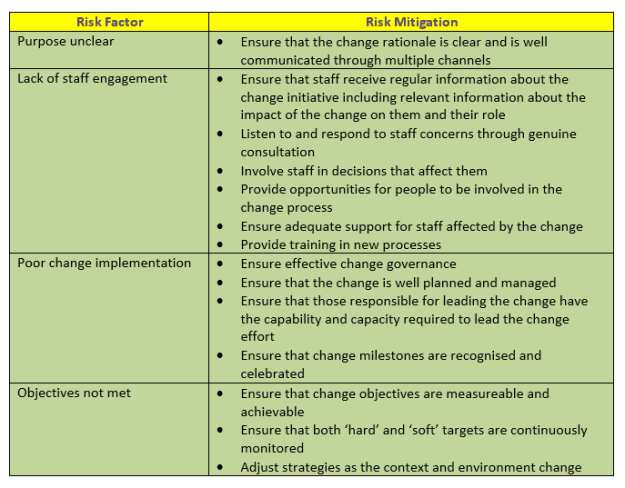 The language of business is often framed in terms of value contribution and opportunity vs risk. As leaders and practitioners of change we need to ensure that we align with this lexicon when discussing our approach to leading change in organisations. The purpose of most change efforts is often to increase organisational value in some substantial way. There is inevitably, of course, always also risk involved that needs to be managed. What is often overlooked (or papered over) when presenting our change initiatives for endorsement are the risks associated with change initiatives and presenting those risks in a transparent way.
The language of business is often framed in terms of value contribution and opportunity vs risk. As leaders and practitioners of change we need to ensure that we align with this lexicon when discussing our approach to leading change in organisations. The purpose of most change efforts is often to increase organisational value in some substantial way. There is inevitably, of course, always also risk involved that needs to be managed. What is often overlooked (or papered over) when presenting our change initiatives for endorsement are the risks associated with change initiatives and presenting those risks in a transparent way.
Risk impact is typically assessed through a risk matrix by considering likelihood and consequence.

Whilst the actual failure rate of organisational change initiatives is open to conjecture (see David Wilkinson’s ‘Common Myths of Organisational Change’) a good predictor of future success may be found in past performance. How effective have recent change initiatives been in your organisation? If we are honest with ourselves, many of us may assess the risk of the Likelihood of our change effort failing, based on past performance, as being at least ‘Possible’, possibly ‘Likely’ and even perhaps ‘Almost Certain’.
The Consequence of the change failing to meet its objectives will depend on the change initiative being undertaken. For a major organisational change effort, we are most likely to be facing at least a ‘Major’ consequence for the organisation if the change completely or partially fails.
Therefore, when looking at the risk profile of major organisational change, the evidence suggests to us that in many organisations we are facing a risk assessment of ‘High’ to ‘Extreme’ for our change initiatives.
Such an honest assessment is rarely found in initiative proposals. Benefits are often highlighted and risk often underplayed – despite the evidence of our past performance. The consequence of underplaying the risk, however, is often to our detriment and may lead to negative outcomes for our organisations and our people. We often lament that ‘management’ doesn’t provide enough support for the change initiative and/or do not engage, consult or involve our people sufficiently. Perhaps though, as leaders and managers of change, this lack of support and engagement is of our own making as we neglect to talk about the risky business of change.
The opportunity that presents itself when we talk more transparently about the ‘High’ to ‘Extreme’ risk of organisational change is that we can also talk about appropriate Risk Treatment. Risk Treatment specifies the options and actions that we can put in place to mitigate risk.
The good news is that there is evidence that points us to effective treatment that can mitigate the risk associated with organisational change.
Whilst the overall risk assessment may be ‘High’ or ‘Extreme’, we can break down the factors of risk and identify the mitigation strategies. For example:

The mitigation strategies for each specific change will be dependent on the organisation and context. Once identified, however, these strategies can be costed in terms of time and resource. You may find that managing the risk associated with your change effort may come at some significant cost. It is a cost, however, that is necessarily required to mitigate the risk and the Risk Treatment can be justified through evidence.
Is it acceptable to your business, for example, to invest $500,000 to mitigate the ‘High’ to ‘Extreme’ risk associated with an initiative that has the potential to add $5M of value to the business?
By adopting the language of business and positioning our organisational change strategies as legitimate, evidence-based risk treatment, our change practice can add value to both our people and our organisations.
Contribute to the Workplace Change Project by completing the Workplace Change survey The link to the survey and to share with your colleagues is here: http://goo.gl/forms/XWiSg0HvlR
